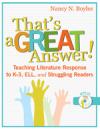 That’s a GREAT Answer! Teaching Literature Response to K-3, ELL, and Struggling Readers
That’s a GREAT Answer! Teaching Literature Response to K-3, ELL, and Struggling ReadersHow can teachers get great answers to open-ended comprehension questions from the students who need help the most: K-3 students, struggling older readers, and English-language learners? The foundation of a great answer starts with great objectives, books, instruction, and discussions. By breaking down objectives into specific, measurable, open-ended comprehension questions that can be correlated with the literacy objectives of any state curriculum, teachers can get great answers from their students.
Try this sample objective and question frame with your students. It works with any fiction or nonfiction literature model and encourages students to write about their initial reactions to the text.
Above all, we want students to find personal meaning in what they read. It’s that personal connection that leads to action: taking a stand on an important issue, fighting for a just cause, reading more
to uncover additional answers. In order for students to have a strong reaction to a text, they need to read something that evokes a strong emotion. The emotion can be positive or negative. But it should make them want to laugh out loud, cry, give someone “a piece of their mind,” hug the main character, etc.
It is also important to provide students with the language to express these reactions. Here are a few powerful words to characterize a reaction: thrilled, horrified, shocked, delighted, astounded,
astonished, depressed, joyful, excited, disgusted, sick, relieved, or peaceful. Work with your students to come up with a “Feeling Words List” from which they can select words to use in their writing.
